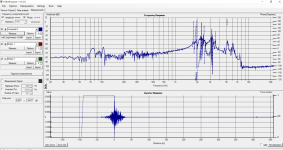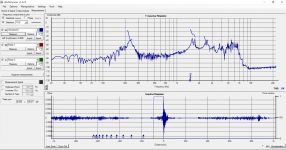Having been used to a pair of cheap 8 ohm 7.5W or 10W speakers on the desktop, I now have some second hand Mordaunt-Short MS35Ti now that I'm using on my DIY amp.
They sound different. I will need to open them up to check the capacitors.
They sound loud without really appearing loud. Not sure how to explain that, perhaps they have less distortion or something.
Is there a phenomenon for this, if so, what is it?
Anything I can do to make sure they are sounding ok?
They sound different. I will need to open them up to check the capacitors.
They sound loud without really appearing loud. Not sure how to explain that, perhaps they have less distortion or something.
Is there a phenomenon for this, if so, what is it?
Anything I can do to make sure they are sounding ok?
Imo it actually is distortion related. With less distortion music appears to be less loud.
Find out if you like the soundAnything I can do to make sure they are sounding ok?
Yes, perceived loudness is directly related to distortion. Some people actually prefer more even order harmonic distortion which makes music sound more interesting to the ears, but the non linear odd order stuff is the bad part you don't want. Your ears can pick up on just 0.1 percent 3rd order distortion in the midrange, not so much down low or up higher. 10 percent or more isn't uncommon in the bass area and our brain fills in the gap if the lowest fundamental bass is missing.
A low distortion speaker will sound boring to most people. It will also sound lower in volume subjectively compared to a higher THD speaker playing at the same SPL.
A low distortion speaker will sound boring to most people. It will also sound lower in volume subjectively compared to a higher THD speaker playing at the same SPL.
I don't have any test tools except a digital multimeter.
Would a Rigol 1054 scope work? I might have to purchase sometime in the future.
Would a Rigol 1054 scope work? I might have to purchase sometime in the future.
If you have a smart phone, you can install the Spectroid app for android from google play. It works well if you set it up right and select the phone's external video recording mic as the input source. You can get fancier with by using the Dayton Audio IMM-6 mic and its really cheap too.
Thanks for the suggestion on the app. I've installed it but don't quite know what to look for once I start analysing the sound. I've configured it to use the camera as the sound source.
There is quite a bit of background noise without any sound playing, which is the extractor fan system in the apartment, so that will turn off in approximately 15 minutes. I also had my work laptop on (which often has loud fan) which is now off, and my desktop has fans but I have to run that for forum replies and for music playback source.
There is quite a bit of background noise without any sound playing, which is the extractor fan system in the apartment, so that will turn off in approximately 15 minutes. I also had my work laptop on (which often has loud fan) which is now off, and my desktop has fans but I have to run that for forum replies and for music playback source.
Yes, perceived loudness is directly related to distortion. Some people actually prefer more even order harmonic distortion which makes music sound more interesting to the ears, but the non linear odd order stuff is the bad part you don't want. Your ears can pick up on just 0.1 percent 3rd order distortion in the midrange, not so much down low or up higher. 10 percent or more isn't uncommon in the bass area and our brain fills in the gap if the lowest fundamental bass is missing.
A low distortion speaker will sound boring to most people. It will also sound lower in volume subjectively compared to a higher THD speaker playing at the same SPL.
The "loud" test is my informal way of determining if a speaker has a lot of distortion or not. If I can turn it up loud and listen without fatigure, then it's a low distortion speaker. How fast I reach for the volume control tells me how much distortion a speaker has. I have a set of Mission 707s that I think sound great at normal volume, but as with most speakers in that overall range, after a while, enough is enough. My RBRs (Revelator woofer, SB29 tweeter) can play loud song after song after song and never get fatiguing.
If you have a smart phone, you can install the Spectroid app for android from google play. It works well if you set it up right and select the phone's external video recording mic as the input source. You can get fancier with by using the Dayton Audio IMM-6 mic and its really cheap too.
Is the following any good?
There's still some noise, even without playing anything, think it might just be room acoustics / desktop PC.
Attachments
If you have a laptop, download REW or HOLM Impulse, both really good and free. All you need is decent microphone, umic is ~$30? And you are professional! But even laptop built in mic should do.
That's interestesting what you say about feeling fatigued. I've only recently got my 80s speaker, but the old ones (which I still use on desktop) I would say I have reached for the volume control often to lower the volume.The "loud" test is my informal way of determining if a speaker has a lot of distortion or not. If I can turn it up loud and listen without fatigure, then it's a low distortion speaker. How fast I reach for the volume control tells me how much distortion a speaker has. I have a set of Mission 707s that I think sound great at normal volume, but as with most speakers in that overall range, after a while, enough is enough. My RBRs (Revelator woofer, SB29 tweeter) can play loud song after song after song and never get fatiguing.
Can't say if that's because of distortion or if I am worried I am being a pest to my neighbours. Would say the psychological component is the latter, but the technical component of that is the former.
Having had such speakers for years, and only just getting my first ever decent speakers, I was trying to work out if it was a mind trick or if there's something quantifiable with how the speakers sound (also an extra unknown is that I have build 2 mono LM3886 amp boards, so that's a variable too, all the previous amps I've had were lower power and probably lower quality and distortion).
In some ways, with the MS35Ti, I feel like I want to increase the volume, rather than decrease. Like I said earlier, I may need to check the capacitors in the crossovers and get them replaced just in case, but I think so far it's likely me not being used to decent speakers or perhaps there's some issue with my DIY amps (thread in Chipamp section).
Last edited:
Maybe the sound is putting you on edge. Even with better speakers this can happen but it is more difficult to tell why.
unmark the 'phase' for now, as its overlapping with fr response
move 'gating' arrow lower to the left to smooth the response
looks like too low level
looks horrible, but its a start 🙂
move 'gating' arrow lower to the left to smooth the response
looks like too low level
looks horrible, but its a start 🙂
To me a flat speaker sounds loud and harch. I like more bass and treble less mid. Then I can really turn it up without ever getting tired. And yes human ear is very sensitive to distortion in the mid area so why not lower it. A smooth sounding system follows the fletcher Munson curves with most energy in the bass IMO. The same of course goes for the music material. And that’s when the problem starts. Every label have a different approach to mastering. Eq, compression all matters in the end result. By the time it reach your stereo it may be destroyed already. So I like to have tone controls.
Last edited:
My 2nd screenshot above has the phase removed.
Sorry, I cannot see how to move the gating label - it's not movable. Is there a setting for it? I don't know if I'm using this software correctly - seems to generate ~6 second tone frequency sweep while I listen to music, and then displays the graphs. Is that correct?
When you say too low level, do you mean it needs to be louder?
I've not got it on very loud, because of neighbours. Speakers are approx 1m away from the laptop, facing the laptop at the same height.
Sorry, I cannot see how to move the gating label - it's not movable. Is there a setting for it? I don't know if I'm using this software correctly - seems to generate ~6 second tone frequency sweep while I listen to music, and then displays the graphs. Is that correct?
When you say too low level, do you mean it needs to be louder?
I've not got it on very loud, because of neighbours. Speakers are approx 1m away from the laptop, facing the laptop at the same height.
you are playing music the same time performing sweep?
that is just wrong
move the dotted line in the lower 'impulse' window
that is just wrong
move the dotted line in the lower 'impulse' window
- Home
- Loudspeakers
- Multi-Way
- Loud without sounding loud?


